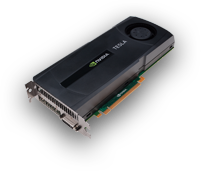
| P-13 | Global magnetohydrodynamic simulations on a mult-GPU system with CUDA and GPU Direct 2.0 Hon-Cheng Wong(Macau University of Science and Technology) Global magnetohydrodynamic (MHD) simulations have a wide range of applications in space physics. Global MHD plays a major role in investigating solar wind–magnetosphere interaction with interplanetary magnetic fields (IMFs) in space. Similar to computational fluid dynamics (CFD) of incompressible flow, huge computation requirement is also the main problem to be solved in global MHD simulations. With the recent development of modern graphics processing units (GPUs) and the Compute Unified Device Architecture (CUDA), it is possible to perform global MHD simulations in a more efficient manner. In this poster, we present a global magnetohydrodynamic (MHD) simulator on a multi-GPU system with eight GPUs. Our implementation is based on the modified leapfrog scheme, which is a combination of the leapfrog scheme and the two-step Lax-Wendroff scheme. GPUDirect 2.0 is used in our implementation, driving multiple GPUs with two CPUs within the system. All data transferring and kernel processing are managed with CUDA 4.0 API instead of using MPI or OpenMP. Data exchange between GPUs is achieved using GPUDirect 2.0, thus avoiding data copying through CPUs. Performance measurements are made on a Multi-GPU system with eight NVIDIA Tesla C2050 (Fermi architecture) graphics cards. These measurements show that our multi-GPU implementation achieves between one and two orders of magnitude of improvement depending on the problem size when comparing to the original serial CPU implementation. |
| P-16 | GPU computing of heated Temperature Sensitive Magnetic Fluid (TSMF), under non-uniform magnetic field Alexandre Renard、岩本悠宏(同志社大学 流体工学(山口)研究室) Ferrofluid is a kind of colloidal fluid, in which magnetic nanoparticles are dispersed in the carrier liquid. The dispersibility of the nanoparticles is quite steady due to the effects of surfactants coated magnetic nano-particles and the Brown motion of them. The ferrofluids have magnetic and fluid characteristics. Temperature-sensitive magnetic fluids (TSMFs) are a kind of ferrofluid, which have temperature-dependent magnetization. The magnetization of TSMF decreases when the temperature increases. Therefore magnetic body force decreases in heated zones when a magnetic field is applied. This unique property can be used to modify the flow behavior, when combined magnetic field and heat source are applied to the TSMF. Thus TSMF can circulate in a heat transport device, under permanent magnetic field, without using any mechanical pump. So enhanced heat transfer can be obtained while saving energy. Industrial applications include cooling down electronic components, such as CPUs. However experimental visualization of TSMF flow behavior is difficult, for TSMF is black and non-transparent. As a result simulations are needed, to understand the flow behavior with combined heat source and non-uniform magnetic field. The CFD (computational fluid dynamics) method used here is the lattice Boltzmann method (LBM). LBM is a relatively recent CFD method, first appeared in the 80s. Unlike the conventional CFD methods, which numerically solve a set of partial differential equations such as the Navier-Stokes equations, the LBM solves a discrete Boltzmann equation- the lattice Boltzmann equation (LBE). The LBM models the fluid consisting of fictive particles, and such particles perform consecutive streaming and collision processes over a discrete lattice mesh. The rules governing the collisions are designed such that the time-average motion of the particles is consistent with the macroscopic hydrodynamics. LBM has several advantages over conventional CFD, especially in dealing with complex boundaries, incorporating microscopic interactions and parallelization of the algorithm. The main algorithm loop of LBM consists in four main steps: equilibrium, collision, macroscopic variables calculation and streaming. For the first three steps (equilibrium, collision, macrovariables) the algorithm is conducted independently on each point of the grid. Therefore the calculation is massively parallel and particularly suitable for GPU. In the streaming part, at time t+dt, each point of the grid gets its value from adjacent points of the grid at time t. Once the array with all grid values of time t has been copied, grid values of time t+dt can be read in parallel on the copied array. So the streaming part is also massively parallel and suitable for GPU. Cuda was implemented in a classic LBM code with very good results. The code was made to run about 10 times faster on NVIDIA Quadro 5000 GPU than on Intel Xeon W3690 CPU (single-threaded) for a mesh grid of 10.000 points. Since each grid points hold nine values (one for each discrete velocity direction) that make 90.000 values to calculate in parallel. This calculation power is used in this study, to investigate the flow behavior of heated magnetic field, under non-uniform magnetic field, in a cylinder pipe. Hybrid thermal lattice Boltzmann equation is carried out. |

